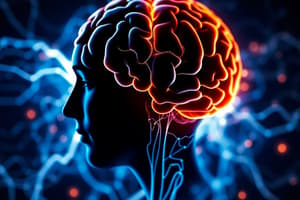Podcast
Questions and Answers
Which component of the Baddeley working memory model is responsible for verbal information processing and temporary storage?
Which component of the Baddeley working memory model is responsible for verbal information processing and temporary storage?
- Episodic Buffer
- Visuospatial Sketchpad
- Phonological Loop (correct)
- Central Executive
What is the primary function of the Visuospatial Sketchpad?
What is the primary function of the Visuospatial Sketchpad?
- To integrate information from the Phonological Loop and Episodic Buffer
- To coordinate the flow of information between components
- To process verbal information
- To process visual and spatial information (correct)
What is the role of the Central Executive in the Baddeley working memory model?
What is the role of the Central Executive in the Baddeley working memory model?
- To store verbal information temporarily
- To process visual and spatial information
- To coordinate the flow of information between components (correct)
- To maintain visual information in working memory
What is the primary function of the Episodic Buffer in the Baddeley working memory model?
What is the primary function of the Episodic Buffer in the Baddeley working memory model?
What is the limited capacity of the working memory system referred to as?
What is the limited capacity of the working memory system referred to as?
What is correlated with individual differences in working memory capacity?
What is correlated with individual differences in working memory capacity?
What is a key factor that influences the Central Executive's capacity?
What is a key factor that influences the Central Executive's capacity?
What is the primary function of the Articulatory Rehearsal Process?
What is the primary function of the Articulatory Rehearsal Process?
What is the consequence of not rehearsing information in the Visuospatial Sketchpad?
What is the consequence of not rehearsing information in the Visuospatial Sketchpad?
What is the average capacity of the Working Memory System in terms of chunks of information?
What is the average capacity of the Working Memory System in terms of chunks of information?
What is the role of the Dorsolateral Prefrontal Cortex in the Baddeley working memory model?
What is the role of the Dorsolateral Prefrontal Cortex in the Baddeley working memory model?
What is the purpose of the Episodic Buffer in the Baddeley working memory model?
What is the purpose of the Episodic Buffer in the Baddeley working memory model?
Flashcards are hidden until you start studying
Study Notes
Baddeley Working Memory Model
The Baddeley working memory model is a theoretical framework that explains how our brains process and store information temporarily. The model consists of multiple components that work together to facilitate cognitive tasks.
Phonological Loop
- Also known as the "articulatory loop"
- Responsible for verbal information processing and temporary storage
- Consists of two sub-components:
- Phonological store: a passive storage system that holds verbal information for a short duration
- Articulatory rehearsal process: an active process that rehearses verbal information to maintain it in working memory
Visuospatial Sketchpad
- Responsible for visual and spatial information processing and temporary storage
- Processes visual information, including shapes, colors, and patterns
- Involved in tasks such as mental imagery and spatial reasoning
Central Executive
- The "CEO" of the working memory system
- Coordinates the flow of information between the Phonological Loop, Visuospatial Sketchpad, and Episodic Buffer
- Responsible for attentional control, decision-making, and problem-solving
- Manages the allocation of resources between different tasks and components
Episodic Buffer
- A temporary storage system that integrates information from the Phonological Loop and Visuospatial Sketchpad
- Holds bound features of information (e.g., linking words with visual images)
- Plays a key role in the formation of new episodic memories
Working Memory Capacity
- Refers to the limited capacity of the working memory system
- Represents the amount of information that can be held and processed simultaneously
- Individual differences in working memory capacity are correlated with cognitive abilities, such as intelligence, learning, and problem-solving.
Baddeley Working Memory Model
- A theoretical framework explaining how our brains process and store information temporarily
- Consists of multiple components working together to facilitate cognitive tasks
Phonological Loop
- Also known as the "articulatory loop"
- Responsible for verbal information processing and temporary storage
- Consists of two sub-components:
- Phonological store: a passive storage system holding verbal information for a short duration
- Articulatory rehearsal process: an active process rehearsing verbal information to maintain it in working memory
Visuospatial Sketchpad
- Responsible for visual and spatial information processing and temporary storage
- Processes visual information, including shapes, colors, and patterns
- Involved in tasks such as mental imagery and spatial reasoning
Central Executive
- The "CEO" of the working memory system
- Coordinates the flow of information between the Phonological Loop, Visuospatial Sketchpad, and Episodic Buffer
- Responsible for attentional control, decision-making, and problem-solving
- Manages the allocation of resources between different tasks and components
Episodic Buffer
- A temporary storage system integrating information from the Phonological Loop and Visuospatial Sketchpad
- Holds bound features of information (e.g., linking words with visual images)
- Plays a key role in the formation of new episodic memories
Working Memory Capacity
- Refers to the limited capacity of the working memory system
- Represents the amount of information that can be held and processed simultaneously
- Individual differences in working memory capacity are correlated with cognitive abilities, such as intelligence, learning, and problem-solving
Baddeley Working Memory Model
- A theoretical framework explaining how working memory functions
Phonological Loop
- Responsible for verbal information processing
- Consists of two components:
- Phonological store: temporarily stores verbal information
- Articulatory rehearsal process: repeats verbal information to maintain it in working memory
- Capacity is limited to around 1-2 seconds of speech
Visuospatial Sketchpad
- Responsible for visual and spatial information processing
- Processes visual and spatial information in working memory
- Capacity is limited, and information can be lost if not rehearsed
Central Executive
- Controls the flow of information between phonological loop, visuospatial sketchpad, and long-term memory
- Responsible for attention, decision-making, and error correction
- Has a limited capacity and can be influenced by factors such as motivation and arousal
Episodic Buffer
- Acts as a "backup" system to integrate information from phonological loop and visuospatial sketchpad
- Temporarily stores and integrates information from different sources
- Plays a crucial role in working memory tasks requiring integration of verbal and visual information
Working Memory Capacity
- Ability to hold and manipulate information in working memory
- Limited capacity, with an average capacity of around 4-6 chunks of information
- Can be improved through practice, training, and strategies such as chunking and rehearsal
Dorsolateral Prefrontal Cortex
- Region in prefrontal cortex involved in working memory
- Plays a key role in central executive system
- Damage to this region can lead to impairments in working memory and executive functions
Studying That Suits You
Use AI to generate personalized quizzes and flashcards to suit your learning preferences.




